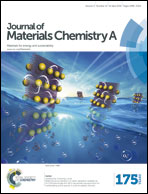An aqueous solution-processed CuOX film as an anode buffer layer for efficient and stable organic solar cells†
Abstract
A facile and green method has been developed for the aqueous solution preparation of CuOX as an anode buffer layer for organic solar cells (OSCs). The CuOX buffer layer is prepared simply by spin-coating a copper acetylacetonate precursor based aqueous solution onto an ITO substrate at room temperature in ambient air. Hydrogen peroxide (H2O2) is used to modify the precursor aqueous solution and can greatly increase the work function of the CuOX film to improve the hole collection efficiency and the charge transport efficiency. UV-ozone post-treatment of the CuOX film leads to the fully oxidized state of copper oxide, which significantly improves the performance of OSCs. Through H2O2 modification and UV-ozone post-treatment on the CuOX anode buffer layer, the highest power conversion efficiency of the OSCs based on PTB7:PC71BM blends reaches 8.68%, which is 10% higher than that of the standard PEDOT:PSS anode buffer layer based OSCs. In addition, the devices with the CuOX buffer layer show much better air stability than those with PEDOT:PSS. Our results indicate that the aqueous solution processed CuOX with low cost and green solvents is a promising anode buffer layer material for efficient and stable OSCs.


 Please wait while we load your content...
Please wait while we load your content...